Search the Special Collections and Archives Portal
Search Results

Transcript of interview with Alison and Michael Chambers by Claytee D. White, October 03, 2013
Date
2013-10-03
Archival Collection
Description
Michael and Alison Chambers might be recent Las Vegas residents, but they have history with the city, having eloped in Las Vegas on December 24, 1982. After spending their lives in California, with a brief stint in western Massachusetts, the couple moved to Las Vegas twenty years later. Both Michael and Alison grew up in the Los Angeles area, graduating from University of Southern California and Mills College respectively. Although Michael received his degree in architecture, his career trajectory transitioned to the financial industry. When Michel and Alison visited the McNeil neighborhood while house-hunting last year, it was immediately clear that the community would be their new home. They both enjoy the close-knit nature of the community, and have become active in the neighborhood association and its social activities. The Chambers’ have quickly integrated into the community, taking advantage of the city’s offerings, including the Art District, downtown renovations, photography club, hidden restaurant gems, and locals discounts.
Text
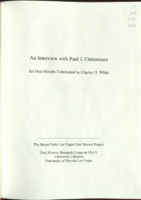
Transcript of interview with Paul J. Christensen by Claytee D. White, February 19, 2008
Date
2008-02-19
Archival Collection
Description
Personal history of Las Vegas through the eyes of a public servant. Growing up in Las Vegas during the 1940s. Education history and childhood memories. Downtown. Experiences in the US Air Force: flying B-47s loaded with nuclear bombs; training. NV Test Site. Family jewelry business in Las Vegas. Election to the board of the Las Vegas Chamber of Commerce. Election to the Las Vegas City Council and the beginning of a career in politics. Jam auction. Tussle with the Clark County Commission over wastewater in the valley: details of the dispute, extended to the state and Environmental Protection Agency. Move to the County Commission and why? The Mob during the 1950s and 60s. The Mormon community in Las Vegas. Howard Hughes. Experiences sitting on the County Commission. Chairman of the Convention Authority. Remarks on Las Vegas' future water supply. Election defeat. Corruption on the County Commission (Erin Kenny). Distinguished Nevadan award. County Hospital. Quick Care Centers. Opinion on the growth of Las Vegas. Speedway Children's Charities. Dina Titus. Experiences with African Americans. Lucy Stewart. Beaver, NV.
Text
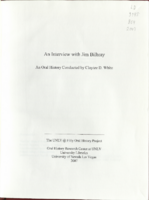
Transcript of interview with Jim Bilbray by Claytee D. White, September 6, 2006
Date
2006-09-06
Archival Collection
Description
Jim Bilbray was born right here in Las Vegas. He attended school here through graduation from Las Vegas High School. As a high school student, he helped collect money to buy the first land on which to build what later became UNLV. After a stint in the National Guard, he enrolled at BYU in Provo for one quarter, and then began attending classes at UNLV. Jim served as student body treasurer at UNLV for one year, and was then elected student body president. He also played on the first tennis team, was a back-up player on the first basketball team, and bowled on the bowling team. In 1959, he transferred to American University in Washington, D.C., graduating with a degree in government and public administration. He then went to law school. In 1965, Jim returned to Las Vegas, looked up some of his old friends, and concluded that they needed to form an alumni association. They created a nonprofit corporation which they named the Nevada Southern Alumni Association. At age 29, he agreed to run for a position on the Board of Regents, and won. His was the key vote which resulted in funding for the Humanities Building. Mr. Bilbray recounts many stories of the early struggles and downright hostilities between UNR and UNLV, struggles over budget, professional schools, and priority lists for buildings. He also relates the efforts he and others made to obtain property for future campus growth, and agrees with Carol Harter's vision of a University mall.
Text
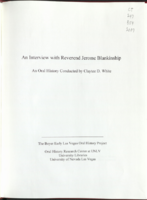
Transcript of interview with Reverend Jerome Blankinship by Claytee D. White, November 24, 2004
Date
2004-11-24
Archival Collection
Description
Jerome Blankinship was born in Hollywood, California in 1933 to Herman and Helen Blankinship. Jerome grew up as an only child in a suburb of Los Angeles called Huntington Park. He spent his entire childhood in the suburb and finished high school there as well. Then he went on to attend the University of Southern California. He received a degree in education and wanted to be a school teacher, but after a short stint in teaching at the Los Angeles City School District, he discovered that it was not for him. He then went back to graduate school and earned a master's in counseling and guidance. After graduating he received a Rockefeller grant to attend seminary, which was a calling that Blankinship had been very interested in. He attended the same seminary school that Martin Luther King Jr. went to, Boston University, School of Theology in Boston. Once finished with seminary, Blankinship pastored a church in the Brentwood area of Los Angeles. Then the Reverend was offered an opportunity in Las Vegas to start a new church. After visiting, Blankinship fell in love with Las Vegas and moved in the summer of 1966 and has been here since. In the interview he shares a vast amount of information about the Las Vegas valley during his early years in the city. Today Blankinship is the senior Chaplain at Sunrise Hospital.
Text
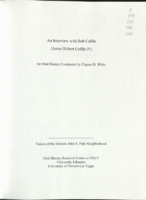
Transcript of interview with Bob Coffin by Claytee D. White, January 29, 2010
Date
2010-01-29
Archival Collection
Description
Bob Coffin [born James Robert Coffin IV] arrived in Las Vegas in 1951. His family moved to find a better climate for their nine-year-old, who suffered from allergies and asthma. His first memory is the long, nine hour drive from California on two-lane highway. The family rented a home in the Huntridge until 1960 when they moved to the John S. Park Neighborhood. He weaves a tale of life in Las Vegas from his perspective of a young politician who admired the neighborhood to becoming the owner of the Gubler home with his wife Mary Hausch in 1987. Bob is a longtime local politician and activist with a special interest in neighborhood preservation. He was elected to the Nevada State Assembly in 1982 and 1984 and to the State Senate in 1986. He offers insights to the past, changing demographics, and the future of the John S. Park Neighborhood. Special note: Mary Hausch, who is married to Bob Coffin, has also been interviewed as part of the Voices of the Historic John S. Park Neighborhood project.
Text
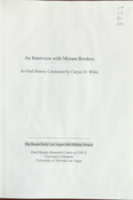
Transcript of interview with Myram Borders by Claytee D. White, February 9, 2009
Date
2009-02-09
Archival Collection
Description
Growing up in Las Vegas, Myram Borders remained in Nevada most of her life. After graduating from high school, she attended the University of Nevada Reno. An internship with United Press International wire service would place her on a career path that included working in Reno, Los Angeles, and then brought her back to Las Vegas in 1965. Her journalism experience with UPI created a foundation for unique insights about living in Las Vegas and the effect gaming had on the world's perceptions of Las Vegas newsworthiness. After her long career with UPI, Myram also worked briefly for Gannett and then became commissioner of Consumer Affairs under Gov. Bob Miller, which she admits was not her favorite work. Her next step was to head up of the Las Vegas News Bureau. As one might expect, Myram has stories about the stories she covered. She recalls how by sheer accident she came upon the scene of Lefty Rosenthal's car being blown up in a parking lot. She explains how a light system was put atop the El Cortez Hotel to signal whether workers were to show up for work at the test site. She covered the first woman dealer in Las Vegas and scooped other reporters to announce Elvis' wedding at the Aladdin.
Text
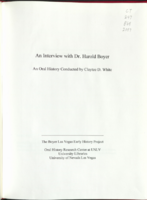
Transcript of interview with Dr. Harold Boyer by Claytee D. White, November 15, 2000
Date
2000-11-15
Archival Collection
Description
Dr. Harold Boyer recalled with great clarity his childhood in Arkansas. Born in 1916 in Hartman, he attended a two-story school which went to eighth grade, fished in a nearby stream, and earned money from the age of six selling newspapers. He remembered that his father wore many hats, including that of town physician, president of the school board, and mayor. He also operated the movie theater and would drive around town announcing upcoming film features through a megaphone. Harold gave details of living through the Great Depression and completing his high school and college education. Dr. Boyer recited many details of his life in the Marine Corps as a medic, serving on active duty in the Pacific arena in WWII, going into medical practice in Oklahoma City and Enid, Oklahoma, and being called back to serve in Korea. In 1952, while checking out practices in several Southwest locations, he came to Las Vegas and interviewed with Dr. Carver Coffman. Harold painted a picture of Las Vegas in the sixties and described his practice and the many organizations in which he participated. He described how certain entities contributed significantly to the growth in the Vegas Valley, including the Convention Bureau, the Elks Club, Rotary Club, Shriners, the Mormon Church, the Mesquite Club, the university, and the gaming industry. He also gave a very positive view of the cultural activities that were/are available to the people of Las Vegas. Comments by Dr. Boyer on race relations recalled the sixties when integration in area schools, hotels, and neighborhoods became a reality under strong black leadership. He also talked about the relationship between casino operators and the civic organizations previously mentioned, and included an anecdote concerning one of his patients and A1 Capone. Helldorado, a unique community celebration, began in 1937 and was designed to draw positive attention to Las Vegas and pull people together. Dr. Boyer described the parades, dances, games, and barbecues that made it so much fun, and listed the founders who made it possible. This list includes people like the Von Tobels, Bob Squires, Bill Ferret, and the Ronzoni family. He related that Helldorado gradually faded out as corporations took over the gaming industry and the population grew to hundreds of thousands. Howard Hughes, the Greenbaums, and Bugsy Siegel are some of the people Dr. Boyer recalled as part of the fabulous tapestry that makes Las Vegas special. He talked about those who had a positive influence on the town, like Ed Von Tobel, Jess Abbott, and Jackie Gaughan. He has wonderful ideas for creating a park near the downtown area that would rival Central Park in New York, Golden Gate Park in San Francisco, or Audubon Park in New Orleans. His closing comments reflect on special projects conducted by the Rotary Club and the future of Las Vegas as an international air travel transportation hub.
Text

Transcript of interview with Judith Boyer by Claytee D. White, November 8, 2005
Date
2005-11-08
Archival Collection
Description
Before moving to Las Vegas, Judith Boyer graduated from the University of Southern California where she received a degree in business merchandising. She grew up in the Los Angeles area as an only child and discusses Southern California, married life and traveling. Judith moved to Las Vegas in November of 1948, worked at Ronzoni's Department Store on Fremont Street and then got the chance to work for Bonanza Airlines as a stewardess. Hostessing for an airline was her dream job and she did it for two years, but gave it up to marry Karsten Bronken and start their family. She discusses Las Vegas as it was in the 1950s. Her memories encompass great stories about the city when people still rode horses around town, participated in Heldorado Parades and enjoyed the early hotels and casinos that were so different from those of today. After her first husband passed away, Judith married Dr. Harold Boyer, who was a dermatologist in Las Vegas for many years. She shares several memories and anecdote
Text
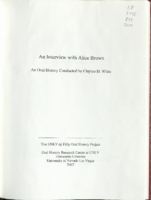
Transcript of interview with Alice Brown by Claytee D. White, October 19, 2005
Date
2005-10-19
Archival Collection
Description
Alice Brown, former UNLV librarian, was born in Cleveland, Ohio. She gives a thorough and fascinating history of her family going back to the 1600s and includes a detailed description of the family home, which may have served as a stop on the antislavery Underground Railroad. Alice attended college in Pennsylvania and earned a library degree at Carnegie. After Pearl Harbor, she enlisted in the Women's Army Auxiliary Corps and served in the U S. and overseas. Upon discharge from the Army, she worked as assistant children's librarian in Cleveland Heights for a time and then followed a friend out to Tacoma, Washington. She worked in the Tacoma Public Library as children's librarian, and also met her husband there. Alice's husband was offered a job in Henderson, Nevada, at the manganese plant. That didn't work out, but he was hired at Titanium right away. Alice describes Henderson as it was in the fifties, and also discusses the state of the libraries in both Henderson and Las Vegas. After the birth of her third child, Alice began working at the University of Nevada Southern Regional Division (now UNLV) part time. This was in 1962, and Alice shares detailed memories of the university campus, library, and faculty and staff from that era. Alice did not slow down after her retirement in 1985. She did volunteer work, traveled, and attended classes at UNLV. Today she volunteers at the Clark County Heritage Museum as a cataloger and at the hospital helping deliver papers and lab work to their various destinations.
Text

Transcript of interview with Judy and John L. Goolsby by Stefani Evans and Claytee D. White, September 8, 2016
Date
2016-09-08
Archival Collection
Description
“So my board basically said, ‘Yes, you can start that community [Summerlin] out there, but you will have to raise the money to do it.’” Thus began John Goolsby’s adventure in master planning and developing Howard Hughes’s 25,000 acres of raw Clark County land. In 1980, four years after Hughes died intestate, Hughes’s Summa Corporation hired Goolsby, a San Antonio, Texas, accountant and real estate professional. His task was to manage Hughes’s extensive portfolio of real estate, the value of which was tied to and dependent on Southern Nevada’s continued economic growth. In this interview, Goolsby and his wife, Judy, recall their first impressions of Southern Nevada’s neighborhoods and schools; share their experiences of building two custom homes—one in Green Valley and one in Summerlin; and Judy describes her early meetings with John’s boss (and Summa’s president and Howard Hughes’s cousin), the genteel William R. Lummis: “I was scared to death of the man. I had never been exposed to anybody like him.” Hughes’s acreage to the West of Las Vegas offered Goolsby the unique opportunity to master plan and build an entire new community from the ground up. He assembled a team that spent two years visiting, researching, and questioning why some master-planned communities succeeded and others did not. They eventually evolved a strategy that included “good schools, good parks, open space, community activities, all the things that Summerlin has today.” They began planning in 1983 and broke ground in 1989. Goolsby’s tenure with Summa reveals larger trends in corporate restructuring in the 1990s through the real estate collapse of 2009. Corporate name changes tell the story: in 1980 Goolsby was hired by Summa Corporation as vice president for real estate; in 1988 the board named him president and in 1990 president and CEO. In 1994 Summa renamed itself The Howard Hughes Corporation. Hughes Corporation was acquired in 1996 by the Rouse Company, although Rouse maintained Summerlin as a separate economic entity with an earn-out agreement. Goolsby retired from Rouse in 1998, but he continued to help manage the earn-out agreement to insure that the Hughes owners received all they were entitled to. In 2004, General Growth Properties purchased Rouse, but a 2009 GGP bankruptcy ended the earn-out agreement. Since 2011, Summerlin has been owned by a GGP spinoff named—ironically—the Howard Hughes Corporation.
Text
Pagination
Refine my results
Content Type
Creator or Contributor
Subject
Archival Collection
Digital Project
Resource Type
Year
Material Type
Place
Language
